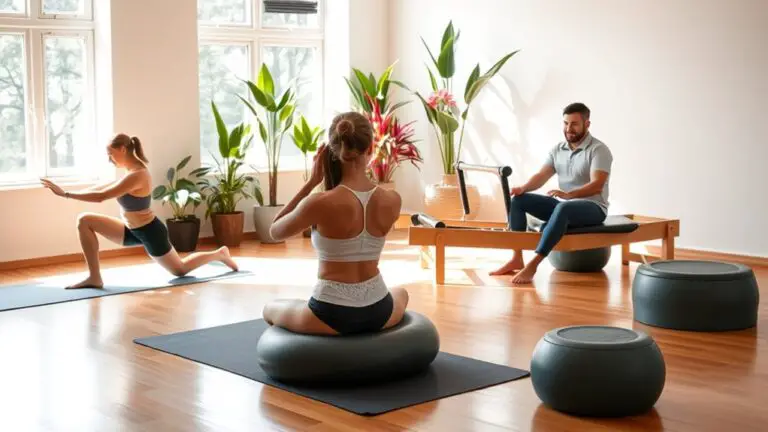How to Use Correct Form to Prevent Common Gym Injuries

Using proper form is essential for preventing gym injuries. Always align your body correctly during exercises—keep your back straight during squats and deadlifts, and maintain a straight line from head to heels in push-ups. Avoid rushing through movements, as this can compromise your technique. Incorporate warm-ups and cooldowns to prepare your muscles and promote recovery. If you’re unsure about your form or experience pain, consider seeking professional guidance to enhance your workout effectiveness. There’s more to discover!
Understanding the Importance of Proper Form

When you think about your workout, it’s easy to focus on how much weight you can lift or how many reps you can do. However, understanding the importance of alignment can transform your fitness routine. Proper form isn’t just about aesthetics; it plays a vital role in biomechanics awareness. When your body is aligned correctly, you distribute the load evenly across your muscles and joints, reducing the risk of injury.
Think about your posture during exercises like squats or deadlifts. Keeping your spine neutral and your knees in line with your toes guarantees that you’re engaging the right muscles effectively. This focus on alignment allows you to maximize your strength output while minimizing strain. As you work out, prioritize form over weight—your body will thank you for it. By developing biomechanics awareness, you’ll not only improve your performance but also cultivate a sustainable, injury-free fitness journey. Additionally, maintaining proper form during exercises can help prevent lower back pain associated with high-impact activities like jumping rope.
Common Form Mistakes to Avoid
When you’re at the gym, being aware of common form mistakes can make all the difference in preventing injuries. Improper lifting techniques and poor posture alignment are two critical areas where many people stumble. By focusing on these aspects, you can enhance your performance and stay safe while working toward your fitness goals.
Improper Lifting Techniques
Improper lifting techniques can lead to serious injuries, so it is crucial to be aware of common form mistakes that many gym-goers make. One major issue is using an improper grip; your hands should be positioned correctly to guarantee even weight distribution and control. An improper grip can increase strain on your wrists and lower back. Additionally, be mindful of your lifting speed. Lifting too quickly can compromise your form and lead to injury. Focus on controlled movements, allowing your muscles to engage properly. Remember, it’s better to lift lighter weights with proper form than to push heavier loads with mistakes. Stay conscious of these common errors, and you’ll greatly reduce your risk of injury while maximizing your workout effectiveness.
Poor Posture Alignment
Maintaining proper posture alignment is just as important as using the right lifting techniques. Poor posture can lead to injuries, hindering your progress. To avoid this, focus on posture correction and alignment techniques. Here’s a quick guide to help you identify common mistakes:
| Common Mistakes | Corrections |
|---|---|
| Slouching shoulders | Keep shoulders back |
| Rounded back | Engage your core |
| Locked knees | Maintain soft knees |
| Forward head position | Align head with spine |
Always check your form in the mirror or ask a trainer for feedback. Remember, your body deserves the best care. By prioritizing good posture, you’ll boost your performance and minimize injury risks. Stay focused and aligned!
Key Exercises for Strengthening Your Technique

To strengthen your technique and prevent injuries, it’s vital to start with a proper warm-up routine that prepares your body. Incorporating essential strengthening exercises will enhance your stability and control. Always keep your focus on form, as this is key to building a solid foundation for your workouts. Additionally, practicing Toes to Bar modifications can help improve your core strength and overall technique while minimizing the risk of injury.
Proper Warm-Up Routine
Before diving into your workout, it’s crucial to prioritize a proper warm-up routine that not only prepares your body but also enhances your technique. Start with dynamic stretching, which helps increase blood flow and flexibility. Movements like leg swings, arm circles, and torso twists activate your muscles and joints, reducing the risk of injuries. Incorporate mobility exercises, such as hip openers and ankle rolls, to improve your range of motion. These exercises not only prepare your body for strength training but also reinforce proper form during your workout. By committing to this warm-up routine, you’ll set the stage for a successful session, allowing you to focus on your performance while minimizing the chances of injury. Remember, a little time spent warming up pays off considerably!
Essential Strengthening Exercises
A solid warm-up lays the groundwork for your workout, but strengthening exercises are equally important for honing your technique and preventing injuries. Focus on building core stability and muscle endurance to enhance your performance and protect against common gym mishaps. Here are essential exercises you can incorporate into your routine:
| Exercise | Focus Area | Benefits |
|---|---|---|
| Plank | Core Stability | Improves core strength |
| Lunges | Lower Body | Enhances muscle endurance |
| Push-Ups | Upper Body | Builds overall strength |
| Deadlifts | Full Body | Promotes stability and power |
These exercises not only target key muscle groups but also help reinforce proper form, so you can lift with confidence and minimize injury risk. Get started today!
Focus on Form
While it’s easy to get caught up in lifting heavier weights or pushing through more reps, focusing on proper form is crucial for long-term success and injury prevention. By practicing mindful movement and developing body awareness, you can enhance your technique. Here are four key exercises to strengthen your form:
- Squats: Keep your back straight and knees aligned with your toes.
- Deadlifts: Engage your core and maintain a neutral spine throughout the lift.
- Push-Ups: Position your hands shoulder-width apart and lower your body while keeping a straight line from head to heels.
- Planks: Verify your elbows are directly under your shoulders and your body remains in a straight line.
Mastering these will help you achieve better results while minimizing injury risks.
Tips for Maintaining Correct Posture

Maintaining correct posture is essential for preventing injuries and enhancing your workout performance. Start by focusing on posture alignment; make certain your head is aligned over your shoulders and your shoulders are back. Engage your core to support your spine, keeping it neutral during exercises.
Incorporate corrective exercises into your routine to strengthen weak muscles and improve overall alignment. Simple movements like planks and bridges can help reinforce proper posture. When lifting weights, remember to hinge at your hips, keeping your back straight and chest proud.
Regularly check in with your body; if you notice slouching or strain, adjust your position immediately. Use mirrors or record yourself to assess your form visually. Finally, don’t hesitate to ask for feedback from trainers. They can provide valuable insight to help you maintain your posture and stay injury-free. Additionally, committing to regular practice of jump rope techniques can enhance your overall fitness and endurance. Commit to these tips, and you’ll not only feel better but also perform better in the gym.
The Role of Warm-Up and Cool-Down in Injury Prevention
Correct posture sets the foundation for a safe and effective workout, but it’s just one part of the equation. To truly prevent injuries, you can’t overlook the importance of warming up and cooling down. Here’s how you can incorporate these practices into your routine:
Correct posture is essential, but warming up and cooling down are equally crucial for injury prevention.
- Dynamic stretches: Engage in movements like arm circles and leg swings to increase blood flow and flexibility before your workout.
- Gradual intensity: Start with lighter weights or slower paces to prepare your muscles and joints for more strenuous activity.
- Cooldown techniques: After your workout, slow down with activities like walking or light jogging to help your heart rate return to normal.
- Static stretching: Finish with stretches focusing on major muscle groups to improve flexibility and decrease soreness. Additionally, warming up can help prevent knee injuries by strengthening muscles around the knees.
When to Seek Professional Guidance for Form Correction

How can you know when it’s time to seek professional guidance for form correction? If you’re experiencing persistent pain during or after workouts, it’s vital to consult a professional trainer. They can provide form assessments to identify any flaws that might lead to injuries. Additionally, if you’re unsure about your technique or can’t progress in your workouts, a trainer can offer valuable insights and personalized feedback. Remember that maintaining a healthy lifestyle is essential, and seeking help can keep you on track.
| Signs to Seek Help | Actions to Take | Benefits of Professional Guidance |
|---|---|---|
| Persistent pain | Schedule a session with a trainer | Injury prevention |
| Unsure about technique | Request a form assessment | Improved performance |
| Plateau in progress | Get personalized program | Enhanced motivation and results |
| Frequent minor injuries | Learn proper techniques | Increased confidence in workouts |
Don’t hesitate to invest in your health—correct form is essential for safe and effective training!
Frequently Asked Questions
What Are the Signs of Improper Form During Workouts?
When it comes to working out, you don’t want to throw caution to the wind. Signs of improper form can include excessive fatigue, discomfort, or pain in unexpected areas. You might notice your body alignment is off if your back rounds during lifts or your knees buckle. These signals are your body’s way of telling you to reassess your technique. Focus on maintaining proper form, and you’ll minimize the risk of injury while maximizing your gains.
How Can I Track My Form Progress?
To track your form progress, start by using form tracking apps or video recordings of your workouts. Regularly review these to spot areas for improvement. Progress monitoring can also involve checking your performance metrics, like weight lifted or reps completed, while ensuring your form stays consistent. Consider getting feedback from a trainer or workout buddy to help you stay accountable. Remember, small adjustments can lead to significant gains in your overall fitness journey!
Are There Specific Warm-Up Exercises for Different Workouts?
Absolutely, there are specific warm-up exercises tailored for different workouts! For strength training, incorporate dynamic stretches like leg swings and arm circles to get your blood flowing. If you’re focusing on flexibility, mobility drills such as hip openers and thoracic rotations can be beneficial. These movements not only prepare your body for the workout ahead but also help prevent injuries. So, take the time to warm up properly, and you’ll perform better!
Can Equipment Affect My Ability to Maintain Proper Form?
Yes, equipment can definitely affect your ability to maintain proper form. If your weights or machines aren’t adjusted to fit your body, you might compromise form stability, leading to potential injuries. Make sure to customize your equipment settings, like seat height or grip width, to suit your physique. This way, you’ll support your movements better, allowing you to focus on your technique and get the most out of your workouts safely.
How Often Should I Reassess My Workout Form?
Did you know that nearly 70% of gym-goers experience an injury at some point? To avoid joining that statistic, it’s crucial to reassess your workout form regularly. Ideally, you should evaluate your form every four to six weeks, especially if you’ve increased your workout frequency or changed exercises. This keeps you mindful of your technique and helps prevent injuries, ensuring you continue to progress safely and effectively in your fitness journey.





